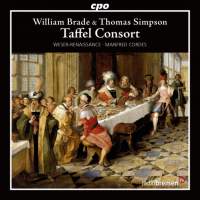Texte paru dans: / Appeared in:

Fanfare Magazine: 37:3 (01-02/2014)
Pour
s'abonner / Subscription information
Les abonnés à Fanfare Magazine ont accès aux archives du
magazine sur internet.
Subscribers to Fanfare Magazine have access to the archives of the magazine
on the net.
CPO
CPO999952

Code-barres / Barcode : 0761203995226
Consultez toutes les évaluations recensées pour ce cd
~~~~ Reach all the evaluations located for this CD
William Brade (1560–1630) and Thomas Simpson (1582–1628?) were both Englishmen who spent much of their active careers in the German states. Brade, a musical cosmopolitan—believed to be the first Englishman to write a piece entitled “canzona,” though others had used the as-yet vaguely formulated structure before him—wandered back and forth through the courts of Brandenburg, Bückeburg, Hamburg, Copenhagen, Halle, and Gottorp, usually staying in any one place for no longer than two years at a time. Simpson, like Brade, was a violinist, composer, and arranger. Like Brade, too, Simpson traveled to Bückeburg, but he first appeared there a decade later, and stayed on for some time.
German rulers of the period frequently employed musicians who copied the Italians, when they weren’t actually Italian, themselves. The 16th-century balletti, with their folk-like themes and danceable rhythms, appealed to those seeking to show off the sophisticated splendor of their courts. The results lack the complexity of Tudor Masses and anthems, viol consorts, and madrigals, but their charm can’t be denied. The same lyrical stream that fed the likes of Dowland, Wilbye, Campion, Farnaby, and even Byrd makes itself felt in this music. These voltas, pavans, allemandes, and courantes are catchy stuff of a high order, well-composed and eminently tuneful.
Manfred Cordes and the Weser-Renaissance of Bremen are no strangers to Fanfare. Here they provide a flexible soft consort with recorder, lute, two violins, four violas da gamba, and continuo. This allows for several configurations: for example, the massed da gamba sound over a positive organ supplies one section to Simpson’s Canzon in C à 5, and switches out with a faster canonic passage (à la chasse) where the recorder and one of the violins trade off entries over the lute. Cordes keeps both rhythms and pace varied.
The sound is variable. At times it is close and full, as in Brade’s Paduana & Galliard in G à 6, but more distant and thin in Simpson’s Ballett “La mia Salome,” with accompaniment obscured. As the album was recorded over three days, I assume some microphone repositioning was tried, and not always successfully. However, it doesn’t obscure the quality of the music, or the performances. With reservations noted, recommended.
Cliquez l'un ou l'autre
bouton pour découvrir bien d'autres critiques de CD
Click either button for many other reviews


